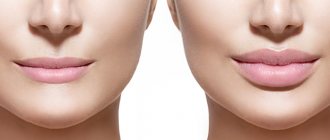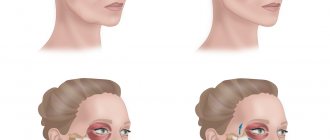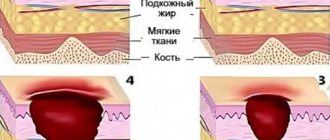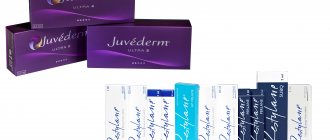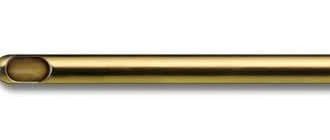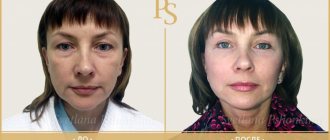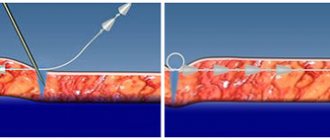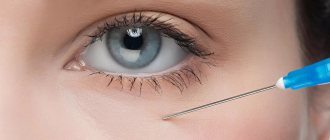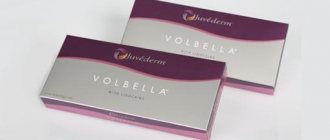Find out more about HD-lifting if you are thinking about plastic surgery and dream of regaining your young, beautiful and vibrant face without the slightest trace of surgical intervention.
HD-lifting is a new method of “smart” plastic surgery that provides ultra-precise, gentle, but at the same time deep restoration of the lines and relief of the face. An additional benefit is the simultaneous restoration of skin quality.
No other lifting technique can offer this! Read to the end and find out exactly how HD-lifting surgery is performed and how it differs from standard anti-aging plastic surgery techniques.
HD-lifting – four levels of facelift.
HD-lifting is the only method that provides deep tightening of soft tissues at all four levels (from the subcutaneous level to the subperiosteal). This technology for total facial rejuvenation provides exactly the result that patients want.
HD-lifting – restoration of the face exactly as in youth, without distortion of features, without the slightest trace of a scalpel!
A minute of anatomy. Soft tissues of the face.
The human face consists of four layers of soft tissue:
- skin,
- subcutaneous fat tissue,
- SMAS (complex of muscles and ligaments of the face and neck),
- periosteum.
Age-related changes affect all these levels. Moreover, in each area of the face they manifest themselves differently. Therefore, the plastic surgeon must take into account not only the anatomical features of the face, but also the individual age-related problems of each zone.
Personal HD rejuvenation plan
Preparation for HD-lifting surgery will begin with a detailed study of the structural features of the bone skeleton and soft tissues of your face. The degree of age-related changes, the density and quality of the skin, and other nuances are taken into account. Your requirements and wishes are taken into account. Even lifting the right and left half of the face will have its own characteristics. After all, faces are never completely symmetrical, and even more so with age.
To finalize the operation plan, an analysis of photographs taken 10-20 years ago is carried out (read more about preparation for the operation in the “Patients” section)
Why does your face look old?
Looking at a person’s face, we, without hesitation, determine his age. What characteristic changes does our eye record and what exactly is automatically perceived as a sign of old age?
- Forehead. Deep wrinkles, drooping “overhanging” eyebrows.
- Middle zone. Ptosis of soft tissues of the zygomatic and cheek areas, nasolabial folds, bags (fatty hernias) under the eyes, wrinkles, excess skin.
- Neck and chin. The “swollen” contour of the face and neck, double chin, unpronounced cervical-mental angle, jowls, “marionette folds.”
HD-lifting is a consistent return of the face to its original (young) state, so it is logical that we begin to correct the tissues that have shifted from top to bottom in the opposite direction - from the neck to the middle, and then the upper zone of the face.
When is volumetric facial modeling performed?
Lately, representatives of the stronger sex have often been visiting specialized clinics for facial correction along with women. The age of patients varies. After all, facial modeling is not always carried out after 40-45 years. If, for example, there has been sudden weight loss and you need to restore sagging skin on your face, then you can resort to such a service even at the age of 30-35.
In this case, you should know that timely correction allows you to achieve the desired cosmetic effect with a minimum dose of the drug. Therefore, the costs will be cheaper.
Volumetric modeling is indicated when:
- your face is drawn and looks exhausted;
- it clearly shows weakening of the muscles, so-called gravitational ptosis;
- “bags” are observed under the eyes;
- have lost the proper volume of the cheekbones and cheeks;
- you want to add plumpness and sensuality to your lips;
- worried about wrinkles in different parts of the face;
- asymmetry has been identified or the outline of the lips has been disrupted;
- folds in the nasolabial area have become more expressive.
Although there are few of them, there are contraindications for which this method of rejuvenation is not recommended. So, correction with fillers is not carried out:
- women who are pregnant or breastfeeding;
- those who have poor blood clotting;
- clients with autoimmune and infectious ailments;
- those who are prone to skin inflammatory processes;
- affected by herpes and other chronic ailments in their acute phase;
- taking medications to prevent blood clots;
- having permanent fillers made of silicone or biopolymers in the area intended for correction.
HD-lifting of the chin and neck
Any face, even the thinnest one, has a certain amount of subcutaneous fat, which tends to “slide” down with age. Gradually, the oval of the face, which in youth resembled the letter “V”, becomes similar to a “U”. To eliminate the problem and restore a clear contour of the lower jaw, multi-level HD-lifting is performed: Ekaterina Sergeevna Kudinova works with deep muscle tissue, fat deposits, and only then with excess skin.
To recreate a clear angle of transition from the neck to the chin, it is necessary, first of all, to get rid of excess fat. To do this, sequential liposuction is performed on all problematic fat deposits in this area. The slender line of the neck is ensured by the restoration of its muscle corset (platysma tightening). And only after completing all the work at the “lower levels” will it be possible to move on to skin lifting.
High-precision HD-lifting provides a much more detailed correction of the lower third of the face and neck . As an example, we will give a solution to one of the most pressing problems - eliminating jowls.
A minute of anatomy. What is platism?
Platysma is the subcutaneous muscle of the neck, the largest of the facial muscles. It is also the thinnest, subject to age-related changes. The platysma goes from the 2nd rib medially and up to the chin, where it branches: some of the platysma bundles go to the lower jaw, and some rise up to the masticatory fascia. With age, the platysma sometimes diverges in the middle, which greatly worsens the tone of the neck.
Drooping corners of the lips - an important sign of age - are also evidence of weakening of the platysma.
During the HD face lift operation, Dr. Kudinova not only removes excess skin and fat on the neck, but also restores weakened platysma, returning the neck to its natural “corset.”
Regenial Idea
Regenyal Idea Lips is an Italian-made filler based on hyaluronic acid.
Is used for:
- Formation of lip volume;
- Correction of minor lip asymmetry;
- Eliminate dryness and flaking.
Regenyal Idea Lips are designed specifically for lip correction. The filler has a very soft texture and blends well with tissues. The removal of hyaluron occurs within 2-4 months.
HD jowl correction.
Few people know that most plastic surgeons simply “bypass” this difficult area so as not to touch the important vessels and large nerves passing through here. The appearance of a jowl lift is achieved by tightening the skin in the adjacent peripheral areas of the face. This approach does not allow obtaining a full-fledged, much less long-term, effect of eliminating jowls.
HD-lifting technology allows you to completely and permanently remove excess fatty tissue in the “jowl” area and tighten the SMAS layer. This gives the surgeon a real opportunity to restore an impeccable lower jaw line. Therefore, the HD rejuvenation effect of the lower face area will be more voluminous and long-lasting.
A detailed approach is one of the most important principles of HD-lifting, and, of course, this applies not only to the jowl area. This approach applies to each and every problem area of the face.
HD-lifting of the middle zone
Working in the central area of the face is perhaps the most critical stage of the operation, because this is where the main facial nerves pass.
The key feature of this stage is individual detachment and tightening at each of the three levels of soft tissue (SMAS, fatty tissue and skin). The plastic surgeon works with each layer separately. This allows you to very accurately restore all the details of the face, correctly tighten both deep and superficial tissues, and consistently fix them in the position where they were many years ago, where they were supposed to be by nature.
Advantages of HD mid-zone lifting:
- Lift without loss . A special technique for double SMAS detachment is designed to more completely restore the characteristic accents of a young face. We make full use of the fabrics, without cutting or discarding anything. In the most difficult cases, the author’s technique “HD duplication of SMAS” is used, which allows you to restore in detail high cheekbones and clear angles of the lower jaw, even in the presence of significant age-related changes. This approach provides a more complete rejuvenation effect and reduces the likelihood of age-related facial tissue deficiency in the long term.
- Double warranty period ! HD technology of double detachment (at the SMAS level and at the skin level) provides the best precision and effectiveness of tightening. Two-level detachment allows for a balanced tightening of tissue at all levels. After surgery, a double layer of connective tissue will form in the areas of detachment. It will become a reliable frame for your youthful face and will preserve the achieved results for a long time. Speaking about the long-term effect of “smart plastic”, it is also worth mentioning the unique technology of distributed fixation of deep tissues (HD-firmware) and the use of proprietary “unloading seams” (for more details, see “Invisible seam”).
- Skin rejuvenation is a wonderful bonus! The technology of skin detachment and tightening developed by Dr. Kudinova ensures its effective “stress” regeneration. Within 3-4 weeks after the lift, you will notice that your skin has become denser and more elastic.
- No bruises and minimal swelling! The correct choice of tissue detachment depth prevents damage to blood vessels and nerve fibers. Preserving the blood supply prevents bruising, minimizes post-operative swelling and speeds up the healing process. Therefore, after HD-lifting surgery, you are guaranteed fast, painless and comfortable rehabilitation.
Main fillers
It turns out that one of the best options to safely and painlessly return youth today is volumetric modeling using fillers. This technique makes it possible to select the right technique based on the individual factors of each person who wants to rejuvenate. The problem of skin aging is solved using a whole set of specially developed products, which are as follows:
- Elements of stabilized hyaluronic acid. Their task is to interact with moisture; these components make it possible to replenish the required volume of specific areas on the face. These elements are hypoallergenic, that is, they do not cause any allergic reactions, and are also non-toxic and biocompatible. You can mention Surgiderm, Revanesse, Teosyal, Repleri. These drugs are used mainly for contouring, biological reinforcement and volumetric correction of the cheeks.
- Components that help the skin produce collagen on its own. Unlike the first category of drugs, they do not stimulate interaction with water at a sufficient level, but by stimulating the production of collagen and elastin at the cellular level, this improves the processes of rejuvenation of the dermis. This category of drugs is also considered absolutely non-toxic and hypoallergenic. Also, a distinctive feature of this type of product is the period of exposure of the elements to the skin. If the first group of funds lasts for a year and a half, then these last for 2-4 years, which is much longer. The most popular drugs in this group are Radiesse and Ellanse.
The choice of fillers is determined individually by a specialist. You can see what the face looks like after volumetric modeling in the photo.
HD-lifting of forehead and eyebrows
Lifting the upper area of the face is the final stage of the HD-lifting operation. It should be noted that forehead plastic surgery is objectively required in no more than half of patients. Therefore, the decision on the need for forehead correction is made individually. The choice of access (incision site) also depends primarily on the characteristics of the face. At least three options are possible, including endoscopic (forehead and eyebrow lift without an incision).
The forehead has a minimum of soft tissue between the skin and the frontal bone. The specific location of the vessels and large branches of the nerves determines the depth of the plastic surgeon’s work. The most effective and safest level of forehead lift is the fourth (subperiosteal).
The surgeon's work at the deepest level is completely safe, since all nerves and vessels pass higher. Another important advantage of such a lift is the long-term effect. The high density of the periosteum helps to maintain the result almost for life.
Features and stages of the contouring procedure
Contour plastic surgery does not require hospitalization and is performed on an outpatient basis in an aesthetic medicine clinic. Only certified and specialized dermatocosmetologists are allowed to perform the procedure. All manipulations are carried out during one session. If complex therapy is necessary, the doctor’s office will have to be visited several times.
Preparations used for sculpting must have a quality certificate and a certificate of passing dermatological control. The duration of the procedure depends on the amount of work: from 30 to 60 minutes. Procedure steps:
- Preparation.
- Consultation with a dermatocosmetologist.
- Makeup removal and skin disinfection.
- Application anesthesia.
- Carrying out modeling plastic surgery.
- Light manual massage.
- Applying a mask.
24 hours before injections, you must avoid physical activity and alcohol consumption. If the patient is taking medications that reduce blood clotting, they must be discontinued 10-14 days before the simulation (only after consultation with a specialized specialist). To prevent herpes, a cosmetologist may prescribe antiviral medications.
During the appointment, the doctor will collect a detailed medical history, make sure there are no contraindications, and determine the need for injections. After which the optimal filler will be selected and its dosage determined.
Makeup and impurities are removed with specially selected cosmetics. Standard antiseptics (miramistin, chlorhexidine) are used for disinfection.
Lidocaine cream or spray is most often used as an anesthetic.
The doctor injects the drug along a pre-planned contour. The filler is injected intradermally, subcutaneously, supraperiostally, using special thin long needles or cannulas. At the end of the administration, the area is re-disinfected.
By massaging, the specialist helps the gel to be distributed more evenly.
Moisturizing and regenerating preparations help the skin to calm down, “come to its senses” after the intervention, and eliminate hyperemia.
Upon completion of all manipulations, the patient will receive a card describing the procedure and the drug used to perform the procedure. If necessary, the doctor will set a date for a re-appointment and provide recommendations for caring for the skin treated with fillers.
Unique “pattern” of Dr. Kudinova
“He believed harmony through algebra...” wrote Pushkin. At the final stage of work, the surgeon moves from eliminating individual problems to the creative act of recreating youth and harmony of the entire face.
The decisive moment of the entire operation is the “cutting” of the skin. The combination of individual facial features into a single harmonious whole depends on its impeccable accuracy. If we consider HD-lifting a new philosophy of plastic surgery, we can call it a transition from quantity to quality. Ekaterina Sergeevna Kudinova calls this stage simply - creating a flawless “face pattern”.
There are no straight lines or sharp angles in nature. Indeed, looking at the face, you will not find a single line that runs “like a ruler.” Therefore, for a completely natural transformation, HD-lifting uses smooth cuts that follow the natural lines of the face. In order for the edges of such complex incisions to fit perfectly (without gatherings, folds, too much or, on the contrary, insufficient tension), precise calculations and the phenomenal intuition of a talented surgeon are required. This is why Dr. Kudinova’s HD-lifting is often called “smart plastic surgery.”
"Invisible seam"
To achieve the ideal rejuvenation effect, it is often necessary to remove quite a lot of excess fat and skin. It is impossible to do this without any cuts at all. The more excess tissue, the longer the incision. This is an objective law that cannot be circumvented without loss of quality.
By choosing the optimal incision length, we can completely remove excess fatty tissue and skin flap. If you do not try to reduce the length of the incision by any means, you can freely choose the optimal natural tightening directions that correspond to the natural tension of the facial tissues and allow you to balance the loads at all levels. After all, our goal is long-term and natural rejuvenation.
We want your face to remain 100% yours after surgery, only 10-20 years younger.
But every cut leaves a seam! Is it sometimes quite long? What should I do? What to choose - a perfect lift or a short incision?
Having created the HD-lifting technique, Dr. Kudinova proposed her own solution to this dilemma - THE INVISIBLE SEAM. Perfect solution! After all, if the seam is not visible, then it is not so important how long it is.
If you think there are no invisible seams, read our blog - INVISIBLE SEAM and check.
